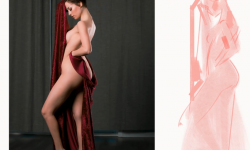Creating Captivating and Magical Cinemagraphs in Photoshop by Ashraful Arefin
Release date:2023, July
Duration:02 h 01 m
Author:Ashraful Arefin
Skill level:Beginner
Language:English
Exercise files:Yes
Creating cinemagraphs can be a captivating way to add motion and life to your images. While it’s true that cinemagraphs can be created using expensive gear and professional setups, you can also achieve impressive results without breaking the bank. Here’s a comprehensive guide that covers the process of creating cinemagraphs from start to finish, including some tips and tricks to make the process easier.
- Understanding Cinemagraphs:
- Definition: A cinemagraph is a still photograph with a subtle, repeated movement in a specific area.
- Examples and Inspiration: Explore various cinemagraphs online to get inspired and understand the possibilities.
- Equipment and Setup:
- Camera: You can use any camera that allows manual control over settings.
- Tripod: Stability is crucial to maintain consistency throughout the image.
- Lighting: Natural light or a simple lighting setup can work well for cinemagraphs.
- Planning and Shooting:
- Concept Development: Decide on the narrative or idea behind your cinemagraph.
- Composition: Compose your image carefully, considering the elements that will be in motion.
- Camera Settings: Shoot in manual mode to have control over exposure, shutter speed, and focus.
- Capturing Video: Record a short video clip that captures the desired motion. Keep it steady and focused on the intended area of movement.
- Software and Editing:
- Video Editing Software: Choose an accessible and user-friendly video editing software such as Adobe Premiere Pro, Final Cut Pro, or even free alternatives like iMovie or DaVinci Resolve.
- Importing and Trimming: Import the video clip into the software and trim it down to the desired length.
- Creating a Still Image Layer: Overlay the video clip on top of the original still image to create a layered composition.
- Masking and Isolating Motion: Use masks or other tools provided by the editing software to reveal the moving parts of the video clip.
- Fine-tuning and Refinement: Adjust the timing and smoothness of the motion, ensuring it looks seamless and natural.
- Exporting: Save the final cinemagraph as a video file or in a format that supports looping, such as GIF or MP4.
- Sharing and Presentation:
- Platforms and Formats: Decide where and how you want to share your cinemagraphs, considering the appropriate format for each platform.
- Optimization: Optimize the file size without compromising the quality to ensure smooth playback on different devices.
Remember, creating cinemagraphs is a creative process, and there are no strict rules. Feel free to experiment with different techniques and effects to achieve the desired results. With practice and patience, you’ll be able to create stunning cinemagraphs using readily available equipment and software. Enjoy the journey of bringing your images to life!





 Channel
Channel





